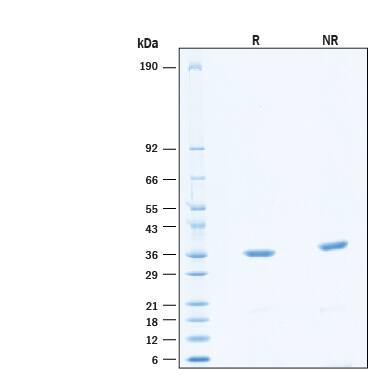Recombinant Human c-Abl His-tag Protein, CF
R&D Systems, part of Bio-Techne | Catalog # 11091-AL

Key Product Details
Product Specifications
Source
E. coli-derived human c-Abl protein
Gly227-Gln513, with an N-terminal Met and 6-His tag
Gly227-Gln513, with an N-terminal Met and 6-His tag
Purity
>90%, by SDS-PAGE under reducing conditions and visualized by silver stain.
Endotoxin Level
<1.0 EU per 1 μg of the protein by the LAL method.
N-terminal Sequence Analysis
Met
Predicted Molecular Mass
34 kDa
SDS-PAGE
33-35 kDa, under reducing conditions
Activity
Measured by its ability to phosphorylate the Abl peptide substrate EAIYAAPFAKKK.
The specific activity is >200 pmol/min/μg, as measured under the described conditions.
The specific activity is >200 pmol/min/μg, as measured under the described conditions.
Scientific Data Images for Recombinant Human c-Abl His-tag Protein, CF
Recombinant Human c‑Abl His-tag Protein SDS-PAGE.
2 μg/lane of Recombinant Human c‑Abl His-tag Protein (Catalog # 11091-AL) was resolved with SDS-PAGE under reducing (R) and non-reducing (NR) conditions and visualized by Coomassie® Blue staining, showing bands at ~33-35 kDa.Formulation, Preparation and Storage
11091-AL
| Formulation | Supplied as a 0.2 μm filtered solution in Tris, NaCl, TCEP and Glycerol. |
| Shipping | The product is shipped with polar packs. Upon receipt, store it immediately at the temperature recommended below. |
| Stability & Storage | Use a manual defrost freezer and avoid repeated freeze-thaw cycles.
|
Background: c-Abl
References
- Sefton, B.M. et al. (1981) Proc. Natl. Acad. Sci. USA 78:1552.
- Bradley, W.D. and A.J. Koleske (2009) J. Cell Sci. 122:3441.
- Gu, J.J. et al. (2009) Immunol. Rev. 228:170.
- Colicelli, J. (2010) Sci. Signal. 14:139.
- Wen, S.T. et al. (1996) EMBO J. 15:1853.
- Taagepera, S. et al. (1998) Proc. Natl. Acad. Sci. USA 95:7457.
- Pluk, H. et al. (2002) Cell. 108:247.
- Hantschel, O. et al. (2003) Cell. 112:845.
- Nagar, B. et al. (2006) Mol. Cell. 21:787.
- Filippakopoulos, P. et al. (2008) Cell. 134:793.
- Shtivelman, E. et al. (1986) Cell. 47:277.
- Wang, J. and A.M. Pendergast. (2015) Trends Cancer 1:110.
- Al Hamad, M. (2021) F1000Res. 10:1288.
Long Name
Abelson Murine Leukemia Viral Oncogene Homolog 1
Alternate Names
ABL1, BCR-ABL1, bcr/abl, cAbl, JTK7
Gene Symbol
ABL1
UniProt
Additional c-Abl Products
Product Documents for Recombinant Human c-Abl His-tag Protein, CF
Product Specific Notices for Recombinant Human c-Abl His-tag Protein, CF
For research use only
